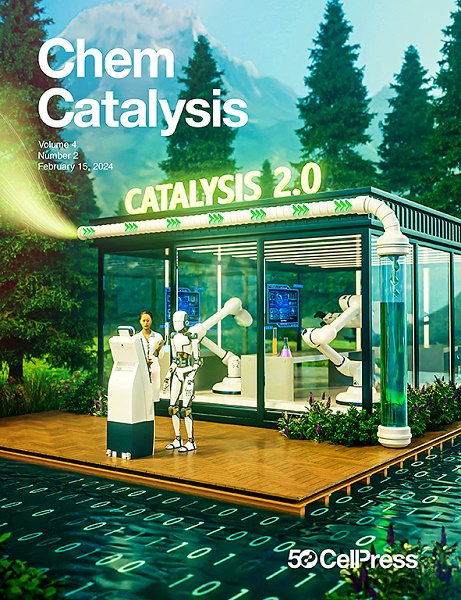调节高熵金属烯的电子密度和界面电场,提高氧还原反应活性
IF 11.6
Q1 CHEMISTRY, PHYSICAL
引用次数: 0
摘要
高熵金属烯(HEMs)结合了高熵合金和超薄纳米片,表现出晶格应变、几何效应和电子调制,提高了氧还原反应(ORR)的活性。我们提出了一种通过调节原子半径和电负性差来控制HEMs中界面电场和态电子密度的策略。原子半径较小的元素(Fe/Co/Ni)与原子半径较大的元素(Pt/Pd/Mo)的集成增加了纳米片的曲率,改变了局部电场。低电负性的Fe/Co/Ni/Mo元素降低了Pd的d带中心,Pt进一步降低了d带中心,降低了氧中间体的吸附能。在0.1 M KOH条件下,在0.9 V条件下(相对于可逆氢电极[RHE]),具有亚纳米厚度、高曲率、微应变和优化电子结构的PtPdFeCoNiMo HEMs的ORR质量活度为1.40 A·mgPt−1,比Pt/C高21倍。它们在20,000次循环后保持优异的性能,降低了速率决定ORR步骤的能量障碍。本文章由计算机程序翻译,如有差异,请以英文原文为准。

Regulating electronic density and interfacial electric field of high-entropy metallenes to enhance oxygen reduction reaction activity
High-entropy metallenes (HEMs), combining high-entropy alloys and ultrathin nanosheets, exhibit lattice strain, geometric effects, and electronic modulation, enhancing oxygen reduction reaction (ORR) activity. We propose a strategy to manipulate the interfacial electric field and electronic density of states in HEMs by adjusting atomic radius and electronegativity differences. Integrating smaller atomic radius elements (Fe/Co/Ni) with larger ones (Pt/Pd/Mo) increases nanosheet curvature, altering the local electric field. Low-electronegativity Fe/Co/Ni/Mo elements lower the d-band center of Pd, and Pt further decreases it, reducing oxygen intermediate adsorption energy. PtPdFeCoNiMo HEMs, with sub-nanometer thickness, high curvature, microstrain, and optimized electronic structure, achieve ORR mass activity of 1.40 A·mgPt−1 at 0.9 V (vs. reversible hydrogen electrode [RHE]) in 0.1 M KOH, 21 times higher than Pt/C. They retain excellent performance after 20,000 cycles, with reduced energy barriers for the rate-determining ORR step.
求助全文
通过发布文献求助,成功后即可免费获取论文全文。
去求助
来源期刊
CiteScore
10.50
自引率
6.40%
发文量
0
期刊介绍:
Chem Catalysis is a monthly journal that publishes innovative research on fundamental and applied catalysis, providing a platform for researchers across chemistry, chemical engineering, and related fields. It serves as a premier resource for scientists and engineers in academia and industry, covering heterogeneous, homogeneous, and biocatalysis. Emphasizing transformative methods and technologies, the journal aims to advance understanding, introduce novel catalysts, and connect fundamental insights to real-world applications for societal benefit.

 求助内容:
求助内容: 应助结果提醒方式:
应助结果提醒方式:


